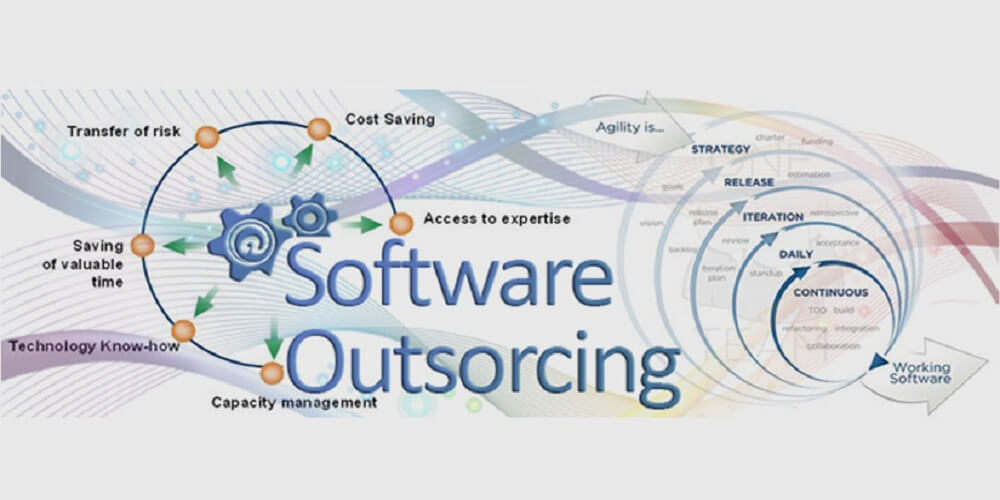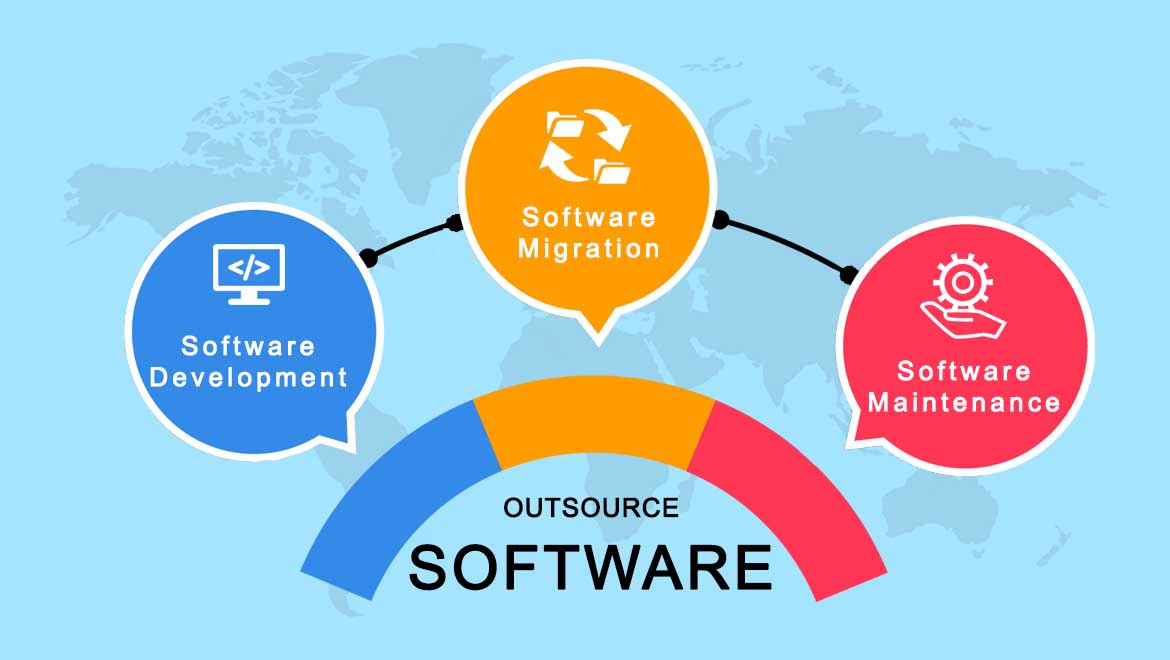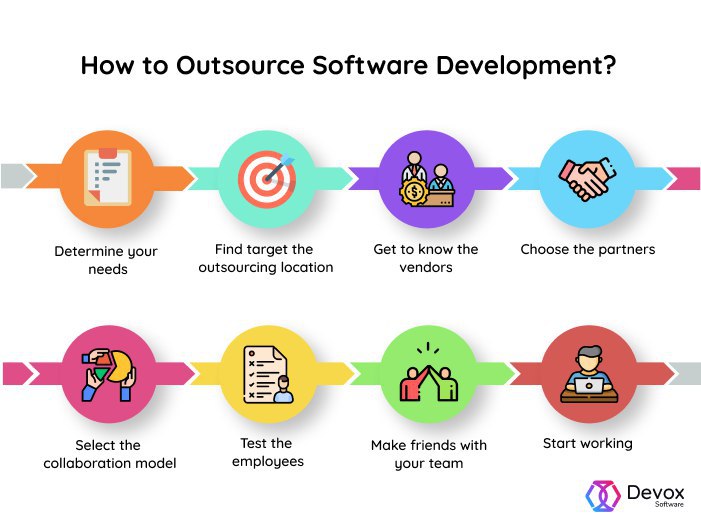Navigating the Complex World of Outsourced Software Development: A Comprehensive Guide for Businesses
 .
.
Welcome! In today’s digital age, software development is no longer a luxury; it’s a necessity. Businesses of all sizes, from startups to established enterprises, rely on software to streamline operations, enhance customer experiences, and drive growth. However, building a robust in-house software development team can be a daunting and costly endeavor. This is where outsourced software development steps in, offering a viable and often more cost-effective alternative.
This comprehensive guide will delve into the intricate world of outsourced software development, providing you with the knowledge and insights needed to make informed decisions for your business. We will explore the various aspects of this approach, from understanding its core principles to navigating the complexities of choosing the right development partner. We’ll also address the potential benefits and drawbacks, empowering you to determine if outsourcing is the right fit for your specific needs.
Let’s start by defining what we mean by "outsourced software development." Essentially, it involves contracting a third-party company or team to handle all or part of your software development project. This can encompass a wide range of tasks, including:
- Requirement Gathering and Analysis: Understanding your business goals, target audience, and specific software needs.
- Software Design and Architecture: Creating the blueprint for your software, outlining its structure, functionalities, and user interface.
- Development and Coding: Writing the actual code that brings your software to life.
- Testing and Quality Assurance: Ensuring the software meets your requirements and functions flawlessly.
- Deployment and Maintenance: Launching your software and providing ongoing support to ensure its smooth operation.
 .
.
 .
.
By outsourcing these tasks, businesses can leverage the expertise of specialized developers, often at a lower cost compared to building an in-house team. This allows them to focus on their core competencies, while relying on external specialists to handle the technical intricacies of software development.
However, the decision to outsource is not without its complexities. It requires careful consideration of various factors, including the type of software project, budget constraints, timelines, and the level of control desired. We will explore these considerations in detail throughout this guide, providing you with the tools you need to make an informed choice.
The Rise of Outsourced Software Development: A Modern Necessity
The demand for software development services has exploded in recent years, driven by the rapid digitization of businesses across all industries. This surge in demand has led to a shortage of skilled software developers, making it challenging for companies to build and maintain in-house development teams.
Moreover, the increasing complexity of software projects requires specialized expertise in various technologies and frameworks. Building an in-house team with such a wide range of skills can be prohibitively expensive and time-consuming.
 .
.
Outsourcing software development has emerged as a logical solution to these challenges, offering businesses a cost-effective and efficient way to access the talent and expertise they need. By partnering with specialized development companies, businesses can tap into a global pool of skilled developers, often at a fraction of the cost of building an in-house team.
Understanding the Different Outsourcing Models: Choosing the Right Fit
The world of outsourced software development offers a variety of models, each with its own strengths and limitations. It’s crucial to understand these models to determine which one aligns best with your project requirements and business goals.
1. Offshore Outsourcing: This model involves hiring a development team located in a different country, typically in regions with lower labor costs. While offering significant cost savings, offshore outsourcing can present challenges in communication, time zone differences, and cultural nuances.
2. Nearshore Outsourcing: This model involves partnering with a development team located in a neighboring country, often sharing similar time zones and cultural values. Nearshore outsourcing offers a balance between cost savings and ease of communication, making it a popular choice for businesses seeking a more localized approach.
 .
.
3. Onshore Outsourcing: This model involves engaging a development team located within the same country as your business. While offering the most seamless communication and cultural understanding, onshore outsourcing can be more expensive compared to offshore or nearshore options.
4. Dedicated Development Teams: This model involves establishing a long-term partnership with a development team that works exclusively on your projects. This provides a high level of control and continuity, but it requires a significant investment and commitment.
5. Project-Based Outsourcing: This model involves engaging a development team for a specific project with a defined scope and timeline. This offers flexibility and cost control, but it may require multiple vendor engagements for ongoing projects.
6. Staff Augmentation: This model involves adding skilled developers to your existing in-house team on a temporary or ongoing basis. This allows you to scale your development capacity without the overhead of hiring full-time employees.
Choosing the right outsourcing model depends on factors such as project complexity, budget constraints, timelines, and communication preferences. Carefully evaluating your needs and comparing the pros and cons of each model will help you make an informed decision.
 .
.
Evaluating Potential Outsourcing Partners: A Critical Step Towards Success
Once you’ve determined the appropriate outsourcing model, the next crucial step is selecting the right development partner. This requires a thorough evaluation process to ensure you choose a company that aligns with your vision, values, and project requirements.
1. Technical Expertise and Experience: Assess the partner’s technical expertise and experience in the relevant technologies and frameworks for your project. Look for a company with a proven track record of successful projects in your industry.
2. Communication and Collaboration: Effective communication is vital for successful outsourcing. Ensure the partner has a clear communication process, including regular updates, progress reports, and open channels for feedback.
3. Project Management and Quality Assurance: Inquire about the partner’s project management methodology and quality assurance processes. Look for a company that follows industry best practices and has a robust system for tracking progress, managing risks, and ensuring high-quality deliverables.
4. Cultural Fit and Values: Consider the partner’s cultural values and work ethics. Ensure they align with your company culture and values to foster a positive and productive working relationship.
5. Client References and Case Studies: Request client references and case studies to gain insights into the partner’s past projects and their ability to deliver successful outcomes.
6. Security and Data Protection: If your project involves sensitive data, ensure the partner has robust security measures in place to protect your information.
7. Cost and Pricing Structure: Carefully review the partner’s pricing structure and ensure it aligns with your budget. Consider factors such as hourly rates, project milestones, and potential hidden costs.
By conducting a thorough evaluation process, you can identify a development partner that meets your specific needs and sets the stage for a successful outsourcing relationship.
Unveiling the Advantages of Outsourced Software Development: A Strategic Advantage
Outsourcing software development offers a compelling set of advantages that can significantly benefit businesses of all sizes. Let’s explore some of the key benefits:
1. Cost Savings: Outsourcing can lead to significant cost savings compared to building and maintaining an in-house development team. This is particularly true for projects requiring specialized skills or for companies with limited budgets.
2. Access to Specialized Expertise: Outsourcing allows businesses to tap into a global pool of skilled developers with specialized expertise in various technologies and frameworks. This provides access to talent that may be difficult or expensive to find in-house.
3. Increased Flexibility and Scalability: Outsourcing offers flexibility in scaling development resources up or down based on project needs. This allows businesses to adapt to changing market conditions and project demands without the overhead of hiring and managing full-time employees.
4. Faster Time to Market: Outsourcing can accelerate the software development process, enabling businesses to bring their products or services to market faster. This can give them a competitive edge in a rapidly evolving digital landscape.
5. Focus on Core Competencies: By outsourcing software development, businesses can free up internal resources to focus on their core competencies, such as product development, marketing, or sales. This allows them to maximize their strengths and drive business growth.
6. Reduced Risk and Liability: Outsourcing software development can reduce the risk associated with managing a large and complex project. The development partner assumes responsibility for the project’s success, mitigating potential risks for your business.
7. Improved Quality and Efficiency: Outsourcing can lead to improved software quality and efficiency through the use of standardized processes, best practices, and experienced development teams.
Recognizing the Potential Disadvantages of Outsourced Software Development: A Balanced Perspective
While outsourcing software development offers numerous advantages, it’s crucial to acknowledge potential drawbacks to make an informed decision.
1. Communication Challenges: Communication can be a challenge with outsourced development teams, especially when working with teams located in different time zones or cultures. This can lead to misunderstandings, delays, and reduced project efficiency.
2. Loss of Control: Outsourcing can lead to a perceived loss of control over the development process. This can be a concern for businesses that prefer a hands-on approach or have strict security requirements.
3. Data Security and Confidentiality: Outsourcing can raise concerns about data security and confidentiality, especially when working with teams located in different countries with varying data protection regulations.
4. Cultural Differences: Cultural differences can impact communication, collaboration, and project outcomes. It’s important to choose a development partner with a strong understanding of your company culture and values.
5. Vendor Dependence: Outsourcing can create a dependence on the development partner, which can be a risk if the partnership dissolves or the vendor experiences issues.
6. Difficulty in Managing Expectations: Managing expectations with outsourced development teams can be challenging, especially when dealing with complex projects or tight deadlines.
7. Lack of Internal Expertise: Outsourcing can lead to a decline in internal software development expertise, as employees may lose skills and experience.
8. Integration Challenges: Integrating outsourced software with existing systems can be complex and time-consuming. This requires careful planning and collaboration between the development partner and your internal IT team.
9. Limited Flexibility and Customization: Some outsourcing models may offer limited flexibility and customization options, as the development partner may have pre-defined processes and methodologies.
10. Difficulty in Finding the Right Partner: Finding a reputable and reliable outsourcing partner can be challenging, requiring thorough research and due diligence.
A Comprehensive Summary of Outsourced Software Development: Key Takeaways
Outsourcing software development can be a strategic decision that unlocks numerous benefits, but it’s crucial to weigh the advantages and disadvantages carefully. Here’s a summary of key takeaways:
Advantages:
- Cost savings
- Access to specialized expertise
- Increased flexibility and scalability
- Faster time to market
- Focus on core competencies
- Reduced risk and liability
- Improved quality and efficiency
Disadvantages:
- Communication challenges
- Loss of control
- Data security and confidentiality concerns
- Cultural differences
- Vendor dependence
- Difficulty in managing expectations
- Lack of internal expertise
- Integration challenges
- Limited flexibility and customization
- Difficulty in finding the right partner
Key Considerations:
- Project complexity and scope
- Budget constraints
- Timelines
- Communication preferences
- Data security and confidentiality requirements
- Cultural fit and values
- Technical expertise and experience of the development partner
- Project management methodology and quality assurance processes
- Client references and case studies
- Cost and pricing structure
By carefully considering these factors and weighing the pros and cons, businesses can make an informed decision about whether outsourcing software development is the right strategy for their specific needs.
Frequently Asked Questions: Addressing Common Concerns
1. Is outsourcing software development right for my business?
The decision to outsource software development depends on your specific needs and circumstances. Consider factors such as project complexity, budget constraints, timelines, and the availability of in-house resources. If you lack the necessary expertise, face tight deadlines, or need to reduce costs, outsourcing may be a viable option.
2. What are the most common outsourcing models?
Common outsourcing models include offshore, nearshore, onshore, dedicated development teams, project-based outsourcing, and staff augmentation. Each model has its own strengths and weaknesses, so it’s crucial to choose the one that aligns best with your project requirements and business goals.
3. How do I find a reputable outsourcing partner?
Look for a development partner with a proven track record of successful projects, a strong reputation in the industry, and positive client testimonials. Conduct thorough research, request references, and evaluate their technical expertise, communication skills, and project management processes.
4. What are the key factors to consider when evaluating potential outsourcing partners?
Key factors include technical expertise, communication skills, project management methodology, quality assurance processes, cultural fit, client references, data security measures, and pricing structure.
5. What are the potential risks associated with outsourcing software development?
Potential risks include communication challenges, loss of control, data security concerns, cultural differences, vendor dependence, difficulty in managing expectations, and integration challenges.
6. How can I mitigate the risks of outsourcing software development?
Mitigate risks by choosing a reputable development partner, establishing clear communication channels, defining project scope and deliverables, implementing robust data security measures, and monitoring project progress regularly.
7. What are the best practices for managing outsourced software development projects?
Best practices include establishing clear communication channels, defining project scope and deliverables, using project management tools, conducting regular progress reviews, providing feedback, and ensuring quality assurance throughout the development process.
8. How can I ensure the quality of outsourced software development?
Ensure quality by defining clear acceptance criteria, implementing rigorous testing procedures, engaging in code reviews, and monitoring project progress closely.
9. What are the common challenges faced by businesses when outsourcing software development?
Common challenges include communication barriers, cultural differences, managing expectations, ensuring data security, integrating with existing systems, and finding the right development partner.
10. How can I ensure the smooth integration of outsourced software with my existing systems?
Ensure smooth integration by defining clear integration requirements, using APIs or other integration tools, conducting thorough testing, and involving both your internal IT team and the development partner.
11. What are the best ways to manage communication with outsourced development teams?
Use a combination of communication channels, including email, instant messaging, video conferencing, and project management tools. Establish clear communication protocols, define roles and responsibilities, and conduct regular meetings to discuss progress and address any issues.
12. How can I measure the success of outsourced software development projects?
Measure success by tracking key metrics such as project timelines, budget adherence, software quality, customer satisfaction, and return on investment.
13. What are the future trends in outsourced software development?
Future trends include the increasing adoption of agile methodologies, the rise of cloud-based development platforms, the growing demand for specialized skills, and the increasing focus on data security and privacy.
Taking Action: Embracing the Power of Outsourced Software Development
The decision to outsource software development is a significant one, but it can be a strategic move that unlocks numerous benefits for your business. By understanding the different models, evaluating potential partners, and addressing potential challenges, you can harness the power of outsourcing to achieve your software development goals.
Don’t be afraid to explore the possibilities and consider outsourcing as a viable option for your next software project. It could be the key to unlocking innovation, driving growth, and achieving your business objectives in the ever-evolving digital landscape.
Disclaimer
This article provides general information about outsourced software development and is not intended to be a substitute for professional advice. The information presented here should not be considered as legal, financial, or technical guidance. It’s recommended to consult with qualified professionals for specific advice tailored to your individual circumstances.
 .
.
